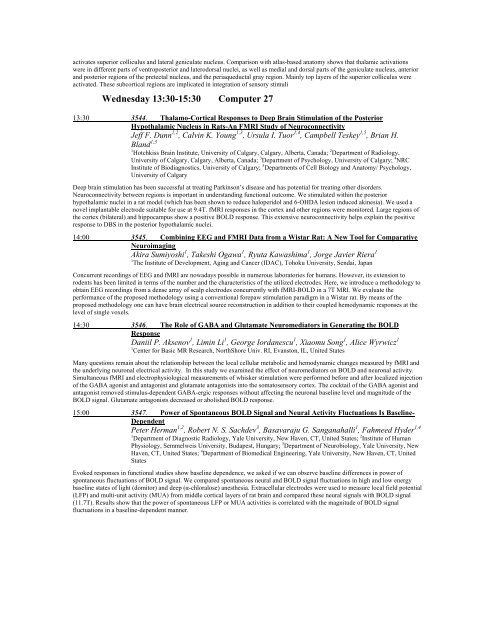ELECTRONIC POSTER - ismrm
ELECTRONIC POSTER - ismrm
ELECTRONIC POSTER - ismrm
You also want an ePaper? Increase the reach of your titles
YUMPU automatically turns print PDFs into web optimized ePapers that Google loves.
activates superior colliculus and lateral geniculate nucleus. Comparison with atlas-based anatomy shows that thalamic activations<br />
were in different parts of ventroposterior and laterodorsal nuclei, as well as medial and dorsal parts of the geniculate nucleus, anterior<br />
and posterior regions of the pretectal nucleus, and the periaqueductal gray region. Mainly top layers of the superior colliculus were<br />
activated. These subcortical regions are implicated in integration of sensory stimuli<br />
Wednesday 13:30-15:30 Computer 27<br />
13:30 3544. Thalamo-Cortical Responses to Deep Brain Stimulation of the Posterior<br />
Hypothalamic Nucleus in Rats-An FMRI Study of Neuroconnectivity<br />
Jeff F. Dunn 1,2 , Calvin K. Young 1,3 , Ursula I. Tuor 1,4 , Campbell Teskey 1,5 , Brian H.<br />
Bland 1,3<br />
1 Hotchkiss Brain Institute, University of Calgary, Calgary, Alberta, Canada; 2 Department of Radiology,<br />
University of Calgary, Calgary, Alberta, Canada; 3 Department of Psychology, University of Calgary; 4 NRC<br />
Institute of Biodiagnostics, University of Calgary; 5 Departments of Cell Biology and Anatomy/ Psychology,<br />
University of Calgary<br />
Deep brain stimulation has been successful at treating Parkinson’s disease and has potential for treating other disorders.<br />
Neuroconnectivity between regions is important in understanding functional outcome. We stimulated within the posterior<br />
hypothalamic nuclei in a rat model (which has been shown to reduce haloperidol and 6-OHDA lesion induced akinesia). We used a<br />
novel implantable electrode suitable for use at 9.4T. fMRI responses in the cortex and other regions were monitored. Large regions of<br />
the cortex (bilateral) and hippocampus show a positive BOLD response. This extensive neuroconnectivity helps explain the positive<br />
response to DBS in the posterior hypothalamic nuclei.<br />
14:00 3545. Combining EEG and FMRI Data from a Wistar Rat: A New Tool for Comparative<br />
Neuroimaging<br />
Akira Sumiyoshi 1 , Takeshi Ogawa 1 , Ryuta Kawashima 1 , Jorge Javier Riera 1<br />
1 The Institute of Development, Aging and Cancer (IDAC), Tohoku University, Sendai, Japan<br />
Concurrent recordings of EEG and fMRI are nowadays possible in numerous laboratories for humans. However, its extension to<br />
rodents has been limited in terms of the number and the characteristics of the utilized electrodes. Here, we introduce a methodology to<br />
obtain EEG recordings from a dense array of scalp electrodes concurrently with fMRI-BOLD in a 7T MRI. We evaluate the<br />
performance of the proposed methodology using a conventional forepaw stimulation paradigm in a Wistar rat. By means of the<br />
proposed methodology one can have brain electrical source reconstruction in addition to their coupled hemodynamic responses at the<br />
level of single voxels.<br />
14:30 3546. The Role of GABA and Glutamate Neuromediators in Generating the BOLD<br />
Response<br />
Daniil P. Aksenov 1 , Limin Li 1 , George Iordanescu 1 , Xiaomu Song 1 , Alice Wyrwicz 1<br />
1 Center for Basic MR Research, NorthShore Univ. RI, Evanston, IL, United States<br />
Many questions remain about the relationship between the local cellular metabolic and hemodynamic changes measured by fMRI and<br />
the underlying neuronal electrical activity. In this study we examined the effect of neuromediators on BOLD and neuronal activity.<br />
Simultaneous fMRI and electrophysiological measurements of whisker stimulation were performed before and after localized injection<br />
of the GABA agonist and antagonist and glutamate antagonists into the somatosensory cortex. The cocktail of the GABA agonist and<br />
antagonist removed stimulus-dependent GABA-ergic responses without affecting the neuronal baseline level and magnitude of the<br />
BOLD signal. Glutamate antagonists decreased or abolished BOLD response.<br />
15:00 3547. Power of Spontaneous BOLD Signal and Neural Activity Fluctuations Is Baseline-<br />
Dependent<br />
Peter Herman 1,2 , Robert N. S. Sachdev 3 , Basavaraju G. Sanganahalli 1 , Fahmeed Hyder 1,4<br />
1 Department of Diagnostic Radiology, Yale University, New Haven, CT, United States; 2 Institute of Human<br />
Physiology, Semmelweis University, Budapest, Hungary; 3 Department of Neurobiology, Yale University, New<br />
Haven, CT, United States; 4 Department of Biomedical Engineering, Yale University, New Haven, CT, United<br />
States<br />
Evoked responses in functional studies show baseline dependence, we asked if we can observe baseline differences in power of<br />
spontaneous fluctuations of BOLD signal. We compared spontaneous neural and BOLD signal fluctuations in high and low energy<br />
baseline states of light (domitor) and deep (α-chloralose) anesthesia. Extracellular electrodes were used to measure local field potential<br />
(LFP) and multi-unit activity (MUA) from middle cortical layers of rat brain and compared these neural signals with BOLD signal<br />
(11.7T). Results show that the power of spontaneous LFP or MUA activities is correlated with the magnitude of BOLD signal<br />
fluctuations in a baseline-dependent manner.
















